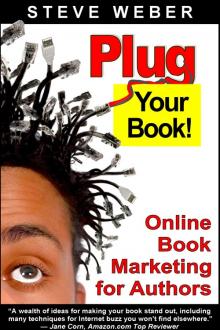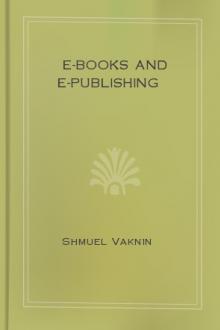Plug Your Book! by Steve Weber (books to read to be successful .txt) 📕

- Author: Steve Weber
- Performer: -
Book online «Plug Your Book! by Steve Weber (books to read to be successful .txt) 📕». Author Steve Weber
The techniques and tools of authorship and online promotion are changing at warp speed. By the time you read this book, several of the details will be out of date--Web addresses change, companies go out of business, and new tools emerge. That's why I publish a companion Web site and blog for this book:
www.PlugYourBook.comThere you'll find a link to Book Updates in the right column, a free reference to additions and changes that didn't make it into this book. While you're at my site, I hope you'll stay for a while to see what else is new, and post your own comments about how future editions of this book can be improved.
If you have questions about this book or anything else related to book marketing and publicity, please write to me at:
Feedback@WeberBooks.comI look forward to hearing from you.
STEVE WEBER
Falls Church, Virginia
Electric word of mouthIn 1988 a first-time author, British mountaineer Joe Simpson, wrote of his disastrous climbing accident in the Peruvian Andes. His book, Touching the Void, got good reviews, but wasn't too popular outside England. It sold modestly and then, like most books, began fading into obscurity.
A decade later, another climbing book was penned by Jon Krakauer, an American journalist who scaled Everest on a harrowing expedition that claimed eight lives. Into Thin Air, with a boost from its conglomerate publisher, was an instant No. 1 bestseller and worldwide blockbuster.
And then something really interesting happened. Bookstores started getting requests for the earlier book, Touching the Void. Weeks before, stores couldn't give it away, and now the book was sold out. Library copies went missing. The original hardback, if you could find one, was going for $375. Harper Paperbacks rushed a new edition onto shelves, and Touching the Void started outselling the new "blockbuster" by two to one.
What happened? Was it a stroke of brilliance by some publishing mogul? No, it was Joe Six-Pack, reacting to book recommendations from Amazon.com. The online store began suggesting the older book to millions of people whom it knew liked climbing books, based on their buying history. If you've shopped on Amazon, you've seen these recommendations yourself: #People who bought _this book _ also bought...#
Many of the new readers liked Touching the Void so much, they wrote rave reviews on Amazon's site. These "amateur" book reviews, written by real climbers and armchair explorers, resonated deeply with the next wave of shoppers. More sales, more good reviews.
Ten years after the book's launch, Internet-powered word of mouth did something that no team of marketing wizards could do--it landed _ Touching the Void_ on the bestseller lists. The story was adapted for an acclaimed docudrama. Simpson, his writing career turbocharged, followed up with four successful adventure books, a novel, and lecture tours.
And this is only the beginning, for Simpson and all of us.
Readers are finally able to find the books they want, even in the smallest niches. Readers are finding their books at Amazon and other Web stores because they offer unmatched choice and convenience. All this is a godsend for authors, who finally have a way to build their audience effectively and inexpensively. Never has it been so practical, so straightforward, for writers to earn a living at their craft and build a following.
Today book readers are helping decide which books sink or swim. As an author, you can hope to be swept along with the tide. Or you can take advantage of this new environment, using the techniques described in this book.
Riding the big riverIn just a few years, Amazon has demolished the barriers to book sales. No longer are new authors summarily locked out of the bookstore. Whether your book was trade-published or self-published, Amazon will not only stock it, but _rearrange the whole store _ when a likely reader arrives. And if your book sells modestly well, Amazon will do lots more--like displaying your book right inside the door, at the end of each virtual aisle, on eight different category shelves, and smack-dab in front of the cash register. Think your local bookstore might do this? Maybe if you're William Shakespeare, but the rest of us are out of luck.
Book sales over the Internet now account for 15 percent of the average publisher's business, up dramatically from 1 percent in 1997. But the real impact is far greater--it's not just the 65 million readers _buying _ their books on Amazon, it's the untold millions more using Amazon's catalog and book reviews to inform their buying choices elsewhere.
Amazon is ground zero for your online campaign. It provides free worldwide exposure--exposure to_ those readers most likely to buy_ your book. Simply having your book properly listed for sale on Amazon can create demand for it everywhere. Whether you're a famous author or an unknown, Amazon is essential because it has a critical mass of buyers using its search engine, recommendations, and reader reviews.
Amazon's 'long tail'Amazon helps create demand for niche books that have a widely dispersed audience that can't be targeted effectively through traditional marketing. These are the books readers often can't find in their local bookstore, or even the library--but they're easy to find on Amazon. Twenty-five percent of Amazon's sales come from obscure books that aren't even carried in a Barnes & Noble superstore stocking 100,000 titles. And the percentage of these "long tail" sales grows every year.
Sure, part of Amazon's appeal is its discount pricing and free shipping offers. But the real value for book buyers is being able to find exactly what they want, says Chris Anderson, author of the 2006 business bestseller The Long Tail:
It's not enough that things be available, you need to be able to find them. The big problem with brick-and-mortar stores is, all shoppers experience the same store. But the problem of findability is solved when you go online. You have searching, recommendations, and all sorts of narrow taxonomies--things can be in multiple categories at the same time.
For 50 years, publishers have been chasing blockbusters--the bestseller hits. They had to, because with limited shelf space, bookstores had to focus on the stuff that moved fastest. Today, chasing blockbusters is obsolete. Authors and publishers have a wide-open opportunity in serving niches.
These niche books are the ones people care about most, and the ones Amazon is most effective in recommending, says Greg Greeley, Amazon's vice president for media products: "The Web site is designed to help customers find books they didn't know existed."
Getting recommendedBook sales are a self-fulfilling prophecy, especially on Amazon. The more people who buy your book, the easier it becomes for the next reader to discover it. When Amazon notices your book is selling, it automatically displays your book higher in its search results and higher in its category lists. And most importantly, Amazon starts plugging your book into book recommendations on its Web site and in e-mails to customers.
Book recommendations are Amazon's biggest sales engine, after keyword searches. Sixty-six percent of sales are to returning customers, many of them acting on automated recommendations for books popular with customers with similar buying histories.
Because they are personalized, Amazon's book recommendations are network-powered word of mouth--more effective than a highway billboard seen by everyone in town. And as long as your book keeps selling, Amazon continues recommending it month after month, year after year, to its likely audience. No longer are books sentenced to the bargain bin three months after publication. Online word of mouth can keep your book alive as long as it satisfies readers.
Personalized bookstoresEach of Amazon's 65 million customers sees a unique store. The layout is personalized, based on which books the customer previously viewed or purchased. Each customer has a recommendations list, based on which books are bought most frequently by other customers with similar buying histories.
If you have an Amazon account, view your recommendations here:
www.Amazon.com/yourstoreAs an author, here's how Amazon recommendations work for you: Let's imagine you've written the book How to Grow Organic Strawberries. It turns out that one of every five Amazon customers who buys your book also purchased an earlier book, Healthy Eating With Organic Fruit. Realizing this, Amazon starts recommending your book to customers who bought the earlier book but haven't yet bought yours. Why? Amazon knows the odds are good that once these readers discover your book they'll buy it, too, and Amazon makes another sale.
Buyers see book recommendations in several places:
On Amazon's home page, where it says, #Hello, [NAME], we have recommendations for you. # Click here to view all your book recommendations.
In e-mails titled #Amazon.com Recommends# ... and #New for You#, periodically sent to Amazon customers.
In the #Gold Box# treasure chest icon at the top right of Amazon's home page. Clicking the box reveals special offers on books and other merchandise on your recommended list.
In a book's #Also-Bought# list. Every book's detail page on Amazon includes a list with the headline #Customers who bought this item also bought#. The Also-Bought list shows the five other books bought most frequently by customers who also purchased the displayed book.
An extended Also-Bought list that includes many more titles is accessible from each book's detail page at the link Explore similar items. Buyers can view the same list during the checkout process by viewing #Customers who bought [Title] also bought...#
The wisdom of crowds#Amazon's recommendations aren't just a computer talking, it's the collective judgment of millions of people acting independently in their own self-interest. Amazon is the biggest and most effective word-of-mouth generator for books because it measures not what people say, but what they_ do._ People don't always recommend their favorite current book to each of their friends and acquaintances. But Amazon factors each buying decision into its recommendations for like-minded customers.
Just as a well-programmed computer can defeat a master chess player, automated recommendations can suggest just the right book, including books that would never occur to a brilliant bookstore clerk, says Amazon chief executive Jeff Bezos:
I remember one of the first times this struck me. The main book on the page was about Zen. There were other suggestions for Zen books, but in the middle of those was a [recommended] book on "How to have a clutter-free desk."
That's not something that a human editor would ever pick. But statistically, the people who were interested in the Zen books also wanted clutter-free desks. The computer is blind to the fact that these things are dissimilar in some way to humans. It looks right through that and says, "Yes, try this." And it works.1
Bubbling to the topThe more your book sells on Amazon, the more frequently it's shown and recommended. Books that sell well on Amazon appear higher in search results and category lists.
Let's imagine your book_ How to Grow Organic Strawberries_ outsells a competing title_, Idiot's Guide to Growing Organic Strawberries_. When Amazon customers search for the keyword "strawberries," your book will appear on top--customers will see it first, and notice it before the competition.
More benefits result from your Amazon sales: Your book moves up in category lists, providing another way for potential readers to discover it. For example, your title on organic strawberries would appear in this Amazon subcategory:
Home & Garden > Gardening & Horticulture > Techniques > OrganicThis subcategory list is like a bestseller list for your niche. Amazon has 35 top-level categories (like Arts & Photography; Business & Investing) divided into dozens more subcategories. Unlike general bestseller lists compiled by the New





Comments (0)